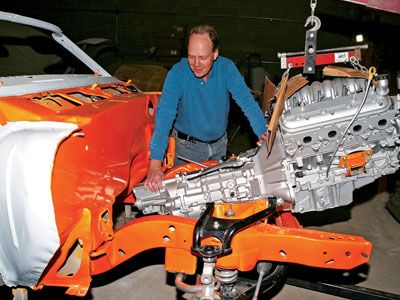
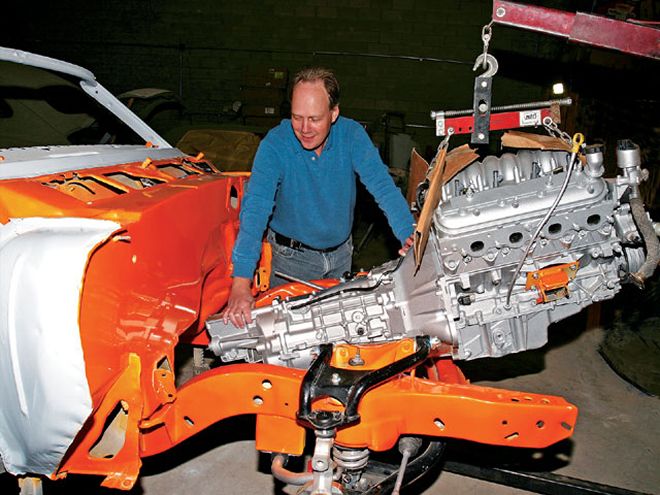
There has been a movement within our hobby over the last several years to update vintage iron with an eye toward modern-day performance, reliability and, most importantly, drivability. Call it Pro Touring, G-Machine, Restomod, MuscleRodTM or what-have-you, advancements in automotive-based engineering, design, electronics, and materials has fostered this cause. Modern transportation can be quicker and quieter, have better handling and braking, and be more efficient than the musclecars of yore; 40-some-odd years of progress will do that.
While many in the hobby embrace the-in-your-face attitude of our Pontiac musclecars and their brutal unabated power surge and resulting roar when the gas pedal is mashed into the loop pile carpet, others yearn to bridge the gap between vintage style and modern utility, power and poise, 10 mpg and 25 mpg.
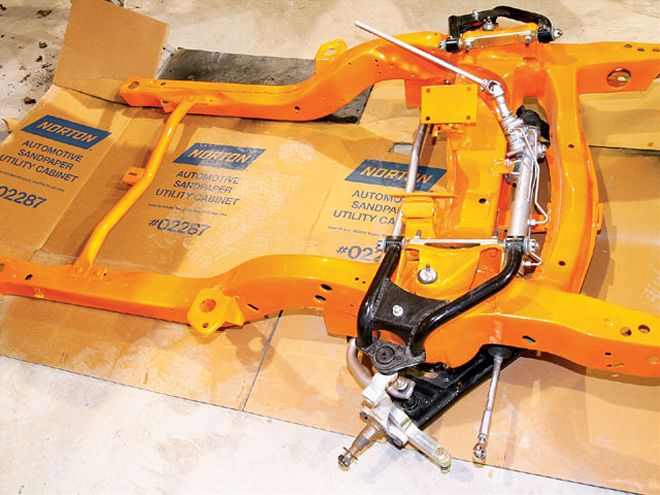 Here's BRP's handiwork dressed in custom paint by Classic Restorations. BRP's new trans crossmember will properly position the six-speed and the custom engine mounts, rack-and-pinion steering, (which eliminates the rear steer linkage), and the relocated stabilizer bar will make the LS1 swap a bolt-in deal.
Here's BRP's handiwork dressed in custom paint by Classic Restorations. BRP's new trans crossmember will properly position the six-speed and the custom engine mounts, rack-and-pinion steering, (which eliminates the rear steer linkage), and the relocated stabilizer bar will make the LS1 swap a bolt-in deal.
They want to participate in events like the Hot Rod Power Tour and other long distance cruises, where their cunning efforts of injecting new-age performance into a classic musclecar can be appreciated. They take pride in staying true to their hot rodding roots, but do not have to endure 98-degree cockpit temps, 4,000 cruise rpm and $60 fuel stops every 200 miles.
HPP has published many stories on these Pro Touring type Pontiacs that use a traditional Pontiac engine mated to an OD transmission to get the revs down on the interstate, factory or aftermarket A/C to keep the interior cool and upgraded suspension, brakes and tires to either reach or surpass the handling capabilities of modern muscle.
Taking the idea of modernizing one a step further, this '69 Firebird convertible will be fitted with a Gen-III LS1 engine-the standard powerplant for the '98-'02 Trans Am and Formula. With horsepower ratings ranging from 305 to 320, the LS1 was developed by GM Powertrain and is not an updated small-block Chevy engine, even though many claim it is. The all-aluminum engine is a clean-sheet-of-paper-design. The fact that GM refers to it as a small-block and that it was also in the Vette, Z28, and Chevy trucks fuels the fire that it's a rehashed Bowtie engine. The attributes of the LS1 have been discussed at length in HPP, so we won't labor the point further here. Suffice it to say that it puts out solid power numbers, is lightweight, and represents the best GM technology that was available when designed.
The '69 Firebird convertible belongs to HPP contributor and owner of Classic Restoration Enterprises, Melvin Benzaquen, and the swap will be performed at his facility. Since this Pontiac will exhibit a Pro Touring theme, Brewer Restoration and Performance (BRP) was tasked with upgrading the existing '69 subframe with one of the company's First-Gen LS1 subframe conversion kits. Installation of BRP's kit will not only allow easy mounting of any LS-series engine, but it will also modernize the suspension, braking and steering systems.
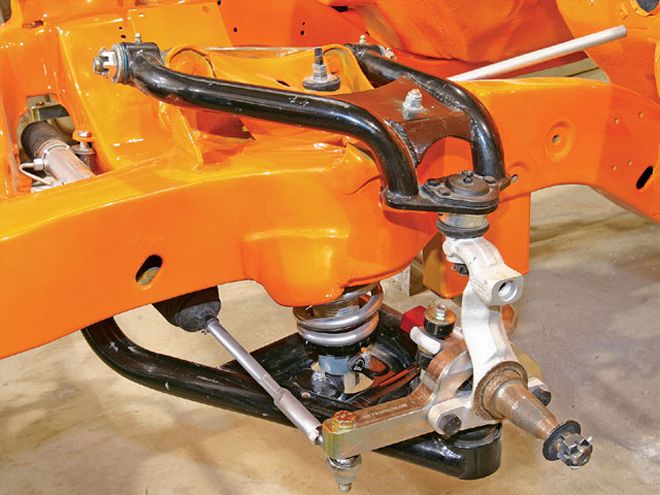 The upper and lower control arms are from Global West, the spindles are stock drum brake '69 F-body and coilover setup is QA1, which is adjustable for both ride height and shock dampening. Note the custom CNC-machined aluminum steering arms BRP made to hook up the steering linkage to the stock '69 spindles.
The upper and lower control arms are from Global West, the spindles are stock drum brake '69 F-body and coilover setup is QA1, which is adjustable for both ride height and shock dampening. Note the custom CNC-machined aluminum steering arms BRP made to hook up the steering linkage to the stock '69 spindles.
Part I will cover the subframe mods and bolting the engine and six-speed trans in to check for proper clearances. In Part II, the electronics, linkages, and accessories will be discussed and an aftermarket A/C unit will be installed.
Decisions, Decisions
As with any other major undertaking, there are a million decisions to be made. Of course, there are cheaper ways to go about this swap, and there are much more expensive ones. Ours represents a middle-of-the-road approach that will satisfy the goals of the owner and not break the bank.
For instance, an LS7 swap would be great since they're all the rage right now for ultimate performance in an LS-series engine. A GMPP crate motor, however, costs approximately $13,000 and more expense will be incurred in changing over other LS7-specific items that will not work with LS1 or LS2 six-speed trans. Conversely, Melvin paid $4,500 for both the 900-mile LS1 and its six-speed trans, which were extricated from a wrecked F-body. The objective isn't to install the most powerful LS engine ever, but rather to modernize the car. If LS7 power is desired at a later date, supercharging, turbocharging, or nitrous are still options.
The Kit
Also affordable is BRP's service that modifies your existing First-Gen subframe to bolt in the LS1 engine, while increasing handling and steering prowess. One of the inherent problems of swapping an LS-series engine into an early Bird is the fact that the rear-steer setup interferes with the oil pan. BRP strips and restores your existing subframe and upgrades it with a power '98-'02 F-body rack and pinion steering system, revised front sway bar mounting, and custom engine mounts to properly place the LS engine and six-speed in the First-Gen engine bay.
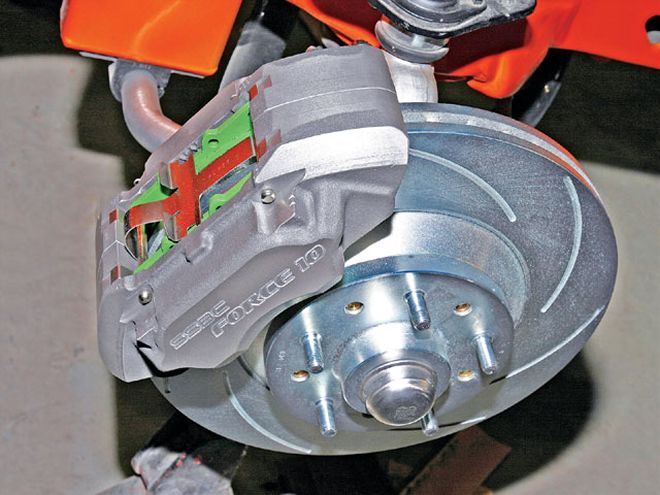 Talk about an upgrade over 9-inch drums, SSBC's Force 10 Extreme 4-piston calipers, low-dust carbon fiber brake pads and massive 13-inch turbo slotted rotors will provide this Bird with some serious whoa power.
Talk about an upgrade over 9-inch drums, SSBC's Force 10 Extreme 4-piston calipers, low-dust carbon fiber brake pads and massive 13-inch turbo slotted rotors will provide this Bird with some serious whoa power.
Options
Melvin also added some options to his subframe. Since BRP works closely with YearOne, we sourced the products from that company, but these and many other options are available through BRP directly. Global West's (GW) tubular upper control arms with Del-A-Lum bushings (Part No. GW249A) were selected because they are lighter than stock, are designed with more caster for better high-speed stability and have less bumpsteer. They are TIG welded and feature billet cross shafts. GW's tubular lower control arms (Part No. GW251L) contain the same build quality as the upper control arms and were made to work with the QA1 Pro Coil shock system (Part No. QA25) so their shock mount areas are reinforced to support the weight of the car. QA1's Pro Coil system allows for ride height adjustments via the threaded shock body and the shock itself features 12-way dampening adjustability. The coil springs have a 250/350-pound progressive rate. Considerably larger than stock, the Addco 1.125-inch stabilizer bar (Part No. AD599GLD) and the Energy Suspension urethane bushings will improve handling by reducing body roll in the corners.
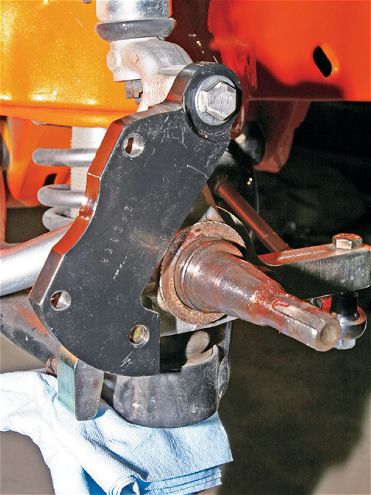 This CNC-machined caliper bracket from Stainless Steel Brakes Corp (SSBC) makes it possible to bolt the company's disc brake caliper to the stock '69 drum brake spindles.
This CNC-machined caliper bracket from Stainless Steel Brakes Corp (SSBC) makes it possible to bolt the company's disc brake caliper to the stock '69 drum brake spindles.
Charged with hauling it all to a stop is a Stainless Steel Brakes Corp (SSBC) kit (Part No. DK33), featuring Force 10 Extreme 4-piston calipers that apply pressure to the low-dust carbon fiber brake pads at both sides of the huge 13-inch Turbo slotted rotors for improved performance over a single piston caliper design. Also included are caliper brackets, an adjustable proportioning valve with gauge, DOT stainless steel flexible hoses, Timken bearings, master cylinder, power brake booster and all hardware.
The Cost
The BRP subframe kit ranges in price from $2,499 to $3,900, depending upon options when you supply the subframe, and BRP provides the parts and the labor to install them. Add $400 to the price if you want BRP to supply the subframe as well. Conversely, a custom subframe with suspension and brakes can cost $3,800 to $7,500. Using the existing subframe also ensures less possible headaches when mounting the core support and front sheetmetal.
Phil Brewer explains, "We engineer these kits to work very well and to be economical, easy to install and easy to maintain." He continued, "In fact, the only reason the First-Gen F-body and Second-Gen X-body kits cost $1,399 [DIY price] is because we have to include rack-and-pinion steering. Our other kits for all A- and G-bodies, and '75 and later X-bodies don't require rack-and-pinion steering, so they're priced under $500." Phil related that BRP has kits for '55-'88 GM cars and can create a kit for any car on a per-order basis.
Dirt Cheap
Of course, there is a lower-buck method to get the engine in the car as well. Moroso and Milodon now offer new LS1 oil pans that are said to fit without subframe mods. You can simply buy the correct engine mounts and trans crossmember from BRP and a pan from Moroso (Part No. 20140) or Milodon (Part No. 30915) to physically bolt the LS engine in. However, you'll still have '60s tech steering, suspension parts and geometry, and brakes-possibly all need to be rebuilt.
Now that you know some of the "whys," lets get to the "hows."
Installing A BRP LS1 Conversion Subframe Kit
Philip Brewer provided photos to take you through the process of installing the BRP kit. T.D.